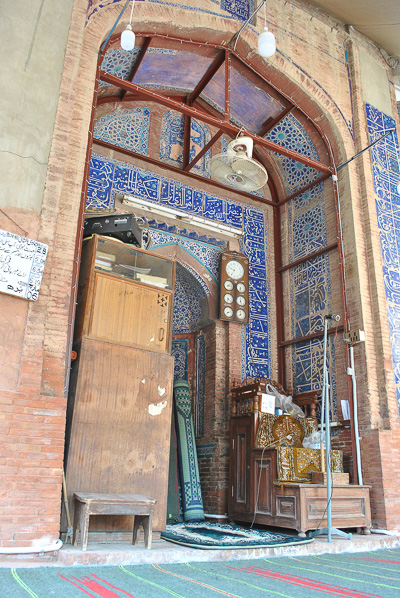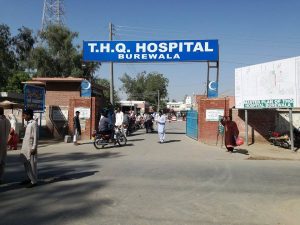Sawi Tomb or Masjid (built 1550s or 1590s-1600) (Urdu: ساوی مسجد)
The so-called Sawi Masjid is located in northwest Multan in the Mohalla Tolay Khan neighborhood. It is a small, roofless structure comprising a set of graves surrounded by walls and an antechamber, all sitting on a high plinth. Although commonly referred to as the Sawi, or “Green” masjid, the structure is more likely an ornamental wall enclosing an important gravesite, with elements of mosque architecture (such as a west-facing mihrab) added to allow for on-site worship.
If the Sawi Masjid is indeed a walled tomb lacking a roof, it is the only known example of that archetype in Pakistan up to the date of its creation, likely in the late 16th or early 17th centuries. Walled, roofless enclosures were common in other parts of central Asia, an early example being the Chashma Ayub Mausoleum in Vobkent, Uzbekistan which was built to surround a spring believed to have been drawn forth by the prophet Job (Ayub). The presence of the elaborately decorated wall with faience paneling and finely carved ornamental screens suggests the grave honors a person of great affluence or significance; however, the copious epigraphy on the marble tombstones (katabah) are primarily Koranic inscriptions rendered in Naskh characters, as well as Persian couplets in Nasta’liq. While beautifully executed, these provide no information on the either of the two deceased honored by the centrally-placed gravestones and cenotaphs. The only reference to the grave’s occupants is a single line describing a certain Safar Quli who died on the tenth of Sha’ban in the Islamic year 999 (corresponding to June 1591 in the common calendar). Credit for the carving of the verses is given to Zakariyya bin Ustad Muhammed, a son of Jeevan, who seems to have installed the tombstones in 1009 AH (i.e., 1600 or 1601 CE). On the opposite side of one of the tombstones a man by the name of Hamiyyat Allah of Balharre claims to have executed the verses. Dr. Shaukat Mahmood, who investigated the tomb, was unable to locate any town by the name of Balharre; hence, its location remains a mystery.
in the late 16th or early 17th centuries. Walled, roofless enclosures were common in other parts of central Asia, an early example being the Chashma Ayub Mausoleum in Vobkent, Uzbekistan which was built to surround a spring believed to have been drawn forth by the prophet Job (Ayub). The presence of the elaborately decorated wall with faience paneling and finely carved ornamental screens suggests the grave honors a person of great affluence or significance; however, the copious epigraphy on the marble tombstones (katabah) are primarily Koranic inscriptions rendered in Naskh characters, as well as Persian couplets in Nasta’liq. While beautifully executed, these provide no information on the either of the two deceased honored by the centrally-placed gravestones and cenotaphs. The only reference to the grave’s occupants is a single line describing a certain Safar Quli who died on the tenth of Sha’ban in the Islamic year 999 (corresponding to June 1591 in the common calendar). Credit for the carving of the verses is given to Zakariyya bin Ustad Muhammed, a son of Jeevan, who seems to have installed the tombstones in 1009 AH (i.e., 1600 or 1601 CE). On the opposite side of one of the tombstones a man by the name of Hamiyyat Allah of Balharre claims to have executed the verses. Dr. Shaukat Mahmood, who investigated the tomb, was unable to locate any town by the name of Balharre; hence, its location remains a mystery.
One other grave of similar quality is located in the northeast corner of the site. It too does not provide any identifying elements and may be the grave of woman, perhaps the wife of Safar Quli (the occupant of the grave to Safar’s side is most likely his eldest son or another male relative). Another grave of modern origin once existed in the southeast corner but was relocated when the mosque was conserved from 2014-17.
Taken as a whole, Ahmad Nabi Khan is of the opinion that the monument dates to 1590 with some later alterations, while Dr. Mahmood provides an earlier date of 1555-56. Both dates book-end the reign of the Mughal emperor Akbar, who ruled from 1556-1605 and exerted considerable architectural influence on the region. In his article, Dr. Mahmood does not specifically justify the earlier date but does note certain Hindu influences (particularly the form of the door jambs and stairs) and notes possible Tughlaq influence such as the presence of two tapering ornamental towers—a hallmark of Tughlaq architecture.
Khan mentions that “…the monument has suffered greatly by neglect and unsympathetic attitude of those who inherited its care and maintenance.” (Khan, p. 183). However, the monument was comprehensively restored from Dec 2014 through April 2017 at a cost of 2.74 million PKR (about $26,000 USD), including the restoration of many ruba’i (Persian couplets) painted on glazed panels. Despite the restoration, evidence of theft in the interim is apparent when comparing Khan’s images (taken prior to 1990) and those of Aown Ali (taken in 2019). For example, a full panel of Persian calligraphy and several fragmentary panels were still present on the antechamber up to 1990, but these fragments are now entirely missing by 2019. The state has since erected a modest fence around the base of the monument to deter casual theft and unauthorized entry, but these are only stopgap measures. Considering the uniqueness of the monument—the earliest enclosed-wall tomb standing in Pakistan—it may be hoped that the authorities concentrate attention on securing this one-of-a-kind monument.
Courtesy: https://www.orientalarchitecture.com/sid/1361/pakistan/multan/sawi-tomb-or-masjid
